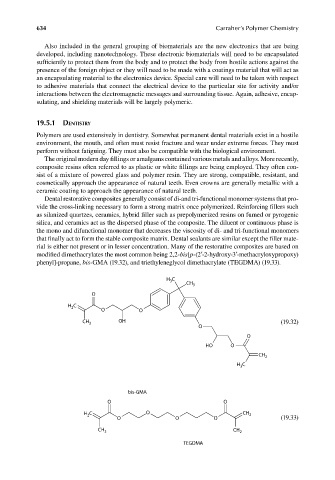Page 671 - Carrahers_Polymer_Chemistry,_Eighth_Edition
P. 671
634 Carraher’s Polymer Chemistry
Also included in the general grouping of biomaterials are the new electronics that are being
developed, including nanotechnology. These electronic biomaterials will need to be encapsulated
sufficiently to protect them from the body and to protect the body from hostile actions against the
presence of the foreign object or they will need to be made with a coatings material that will act as
an encapsulating material to the electronics device. Special care will need to be taken with respect
to adhesive materials that connect the electrical device to the particular site for activity and/or
interactions between the electromagnetic messages and surrounding tissue. Again, adhesive, encap-
sulating, and shielding materials will be largely polymeric.
19.5.1 DENTISTRY
Polymers are used extensively in dentistry. Somewhat permanent dental materials exist in a hostile
environment, the mouth, and often must resist fracture and wear under extreme forces. They must
perform without fatiguing. They must also be compatible with the biological environment.
The original modern day fillings or amalgams contained various metals and alloys. More recently,
composite resins often referred to as plastic or white fi llings are being employed. They often con-
sist of a mixture of powered glass and polymer resin. They are strong, compatible, resistant, and
cosmetically approach the appearance of natural teeth. Even crowns are generally metallic with a
ceramic coating to approach the appearance of natural teeth.
Dental restorative composites generally consist of di-and tri-functional monomer systems that pro-
vide the cross-linking necessary to form a strong matrix once polymerized. Reinforcing fi llers such
as silanized quartzes, ceramics, hybrid filler such as prepolymerized resins on fumed or pyrogenic
silica, and ceramics act as the dispersed phase of the composite. The diluent or continuous phase is
the mono and difunctional monomer that decreases the viscosity of di- and tri-functional monomers
that finally act to form the stable composite matrix. Dental sealants are similar except the fi ller mate-
rial is either not present or in lesser concentration. Many of the restorative composites are based on
modified dimethacrylates the most common being 2,2-bis[p-(2′-2-hydroxy-3′-methacryloxypropoxy)
phenyl]-propane, bis-GMA (19.32), and triethyleneglycol dimethacrylate (TEGDMA) (19.33).
C
H 3
CH 3
O
H C
2
O O
CH 3 OH (19.32)
O
O
HO O
CH 2
3
H C
bis-GMA
O O
C O CH
H 2 2
O O O (19.33)
CH 3 CH 2
TEGDMA
9/14/2010 3:44:02 PM
K10478.indb 634 9/14/2010 3:44:02 PM
K10478.indb 634

